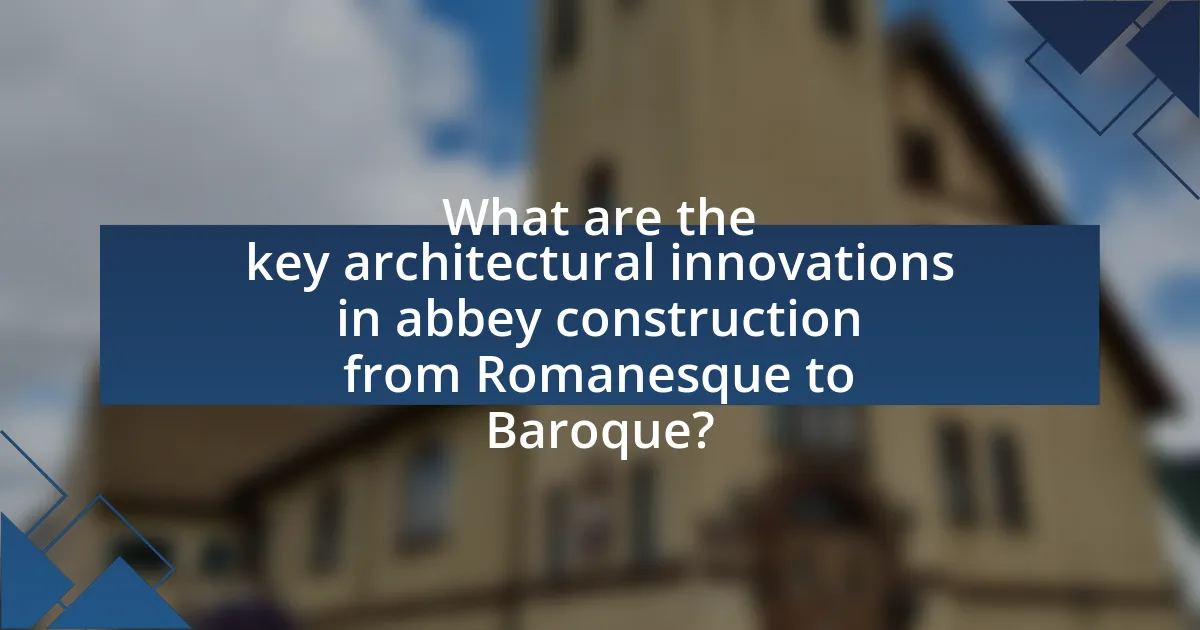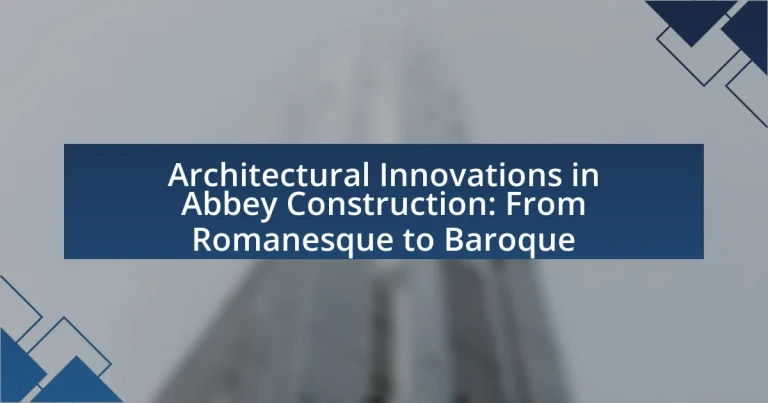The article focuses on the architectural innovations in abbey construction from the Romanesque to the Baroque periods. It outlines the evolution of design elements, beginning with the robust structures of Romanesque architecture characterized by thick walls and rounded arches, transitioning to the height and light of Gothic architecture with features like flying buttresses and pointed arches. The discussion further explores the ornate characteristics of Baroque architecture, emphasizing dynamic forms and elaborate ornamentation. Additionally, the article examines the influence of cultural and religious factors, the impact of monastic orders, and regional variations on abbey design, highlighting how these elements shaped the functionality and aesthetics of these significant religious structures.

What are the key architectural innovations in abbey construction from Romanesque to Baroque?
Key architectural innovations in abbey construction from Romanesque to Baroque include the transition from thick walls and small windows in Romanesque architecture to the use of flying buttresses and large stained glass windows in Gothic architecture, which allowed for greater height and light. Additionally, the Baroque period introduced elaborate ornamentation, dynamic forms, and the use of new materials like stucco, enhancing both the aesthetic and structural capabilities of abbeys. These innovations reflect a shift towards more verticality, light, and decorative complexity, marking significant advancements in architectural design and engineering techniques during these periods.
How did Romanesque architecture influence abbey design?
Romanesque architecture significantly influenced abbey design by introducing features such as thick walls, rounded arches, and barrel vaults, which provided structural stability and a sense of grandeur. These elements allowed for larger and more durable buildings, accommodating monastic communities and their activities. The use of semi-circular arches and ribbed vaults, characteristic of Romanesque style, facilitated the creation of expansive interiors that enhanced the spiritual atmosphere within abbeys. Additionally, the emphasis on symmetry and proportion in Romanesque design contributed to the aesthetic appeal of abbeys, making them prominent landmarks in their regions. Historical examples, such as the Abbey of Cluny in France, illustrate how these architectural innovations were implemented, showcasing the lasting impact of Romanesque architecture on the design of religious structures.
What are the defining characteristics of Romanesque abbeys?
Romanesque abbeys are characterized by their robust structure, semi-circular arches, thick walls, and large towers. These architectural features reflect the need for fortification and stability during the medieval period. The use of barrel vaults and groin vaults in the ceilings allowed for the creation of expansive interior spaces, while the incorporation of decorative elements such as sculpted capitals and intricate reliefs added aesthetic value. Additionally, Romanesque abbeys often included cloisters, which served as tranquil spaces for monastic life, and were typically oriented to the east to align with liturgical practices.
How did structural innovations in Romanesque architecture enhance abbey functionality?
Structural innovations in Romanesque architecture, such as the use of thick walls, rounded arches, and barrel vaults, significantly enhanced abbey functionality by providing greater stability and durability. These features allowed for larger interior spaces, which facilitated communal activities and worship, essential for monastic life. Additionally, the incorporation of buttresses helped distribute weight more effectively, enabling the construction of taller structures with larger windows, thus improving natural light within the abbey. This combination of structural elements not only supported the physical integrity of the buildings but also created an environment conducive to the spiritual and communal practices central to abbey life.
What role did Gothic architecture play in the evolution of abbey construction?
Gothic architecture significantly influenced the evolution of abbey construction by introducing structural innovations such as pointed arches, ribbed vaults, and flying buttresses. These features allowed for taller, more spacious interiors and larger windows, which enhanced the use of light and created an ethereal atmosphere within abbeys. The Abbey of Saint-Denis, rebuilt in the 12th century under Abbot Suger, exemplifies this transition, showcasing the early use of Gothic elements that would become standard in later abbey designs. This architectural style not only improved the aesthetic appeal of abbeys but also facilitated the construction of more complex and ambitious structures, marking a departure from the heavier, more solid forms of Romanesque architecture.
What are the main features of Gothic abbeys?
The main features of Gothic abbeys include pointed arches, ribbed vaults, and flying buttresses. Pointed arches allow for greater height and stability, while ribbed vaults distribute weight more efficiently, enabling the construction of expansive ceilings. Flying buttresses support the walls from a distance, allowing for larger windows and more light, which is characteristic of Gothic architecture. These elements collectively enhance the structural integrity and aesthetic appeal of Gothic abbeys, exemplified by notable structures such as the Abbey of Saint-Denis in France, which is often considered a pioneering example of Gothic design.
How did the use of flying buttresses impact the design of Gothic abbeys?
The use of flying buttresses significantly transformed the design of Gothic abbeys by allowing for higher walls and larger windows. This architectural innovation enabled the construction of expansive stained glass windows, which filled the interiors with light and enhanced the spiritual atmosphere. The structural support provided by flying buttresses distributed the weight of the roof and walls, permitting the inclusion of intricate designs and verticality that characterized Gothic architecture. Historical examples, such as the Notre-Dame de Paris, illustrate how flying buttresses facilitated the elevation of the nave and the incorporation of elaborate decorative elements, marking a departure from the heavier, more solid forms of Romanesque architecture.
What innovations emerged during the transition from Gothic to Baroque in abbey architecture?
The transition from Gothic to Baroque in abbey architecture introduced several key innovations, including the use of grander scale and elaborate ornamentation. Baroque architecture emphasized dynamic forms, such as curves and oval shapes, which replaced the verticality and pointed arches characteristic of Gothic structures. Additionally, the incorporation of light and shadow through large windows and intricate ceiling designs became prominent, enhancing the dramatic effect of interiors. The use of new materials, such as stucco and marble, allowed for more intricate detailing and a sense of movement in the design. These innovations reflect a shift towards a more theatrical and emotional expression in architecture, aligning with the Baroque period’s artistic goals.
How did Baroque aesthetics redefine abbey interiors?
Baroque aesthetics redefined abbey interiors by emphasizing grandeur, dramatic use of light, and intricate ornamentation. This style introduced expansive spaces adorned with elaborate frescoes, gilded details, and dynamic forms, contrasting sharply with the more austere Romanesque designs. Notable examples include the use of curved lines and theatrical elements, as seen in the Abbey of Melk in Austria, which features a stunning combination of architecture and art that creates a sense of movement and emotional engagement. The incorporation of large windows allowed for natural light to enhance the visual impact of the interiors, further elevating the spiritual experience within these spaces.
What structural advancements were introduced in Baroque abbey construction?
Baroque abbey construction introduced several structural advancements, notably the use of grandiose domes, extensive use of light through large windows, and the incorporation of complex spatial arrangements. These features allowed for more dramatic interior spaces and enhanced the overall aesthetic appeal. The use of elliptical shapes in floor plans and the implementation of new materials, such as reinforced stone and elaborate stucco, further contributed to the structural integrity and visual impact of Baroque abbeys. Historical examples, such as the Abbey of Melk in Austria, showcase these advancements, demonstrating how they facilitated a shift from the more austere Romanesque style to the ornate Baroque aesthetic.

How did cultural and religious factors influence abbey architectural innovations?
Cultural and religious factors significantly influenced abbey architectural innovations by dictating design elements that reflected spiritual beliefs and societal values. For instance, the transition from Romanesque to Gothic architecture was driven by the desire to create spaces that inspired awe and facilitated worship, leading to innovations such as pointed arches and ribbed vaults that allowed for taller structures and larger windows. These changes were rooted in the cultural emphasis on divine light and the heavenly realm, as seen in the construction of cathedrals like Chartres, which featured extensive stained glass to illuminate the interior with colorful light, symbolizing the presence of God. Additionally, monastic communities sought to embody ideals of order and harmony in their designs, resulting in layouts that emphasized symmetry and proportion, as exemplified by the Cistercian abbeys that prioritized simplicity and functionality in their architecture.
What was the impact of monastic orders on abbey design?
Monastic orders significantly influenced abbey design by establishing architectural standards that emphasized functionality, spirituality, and community. The Benedictine order, for example, introduced the cloister as a central feature, promoting meditation and communal living, while Cistercian monks prioritized simplicity and austerity, leading to the development of more streamlined and less ornate structures. These design principles were reflected in the layout of abbeys, which often included essential spaces such as the church, dormitory, refectory, and gardens, all arranged to facilitate monastic life. The impact of these orders is evident in the evolution of architectural styles from Romanesque to Baroque, where the integration of these functional and spiritual elements became increasingly sophisticated, showcasing the orders’ lasting legacy on abbey architecture.
How did the Benedictine order shape the architectural features of abbeys?
The Benedictine order significantly influenced the architectural features of abbeys by promoting a design that emphasized functionality, community, and spirituality. This order established the monastic rule, which included guidelines for communal living and worship, leading to the development of large, organized spaces such as cloisters, refectories, and chapels. The use of Romanesque architecture, characterized by thick walls, rounded arches, and barrel vaults, was prevalent in early Benedictine abbeys, providing both structural integrity and a sense of solemnity. Additionally, the emphasis on liturgical functions led to the incorporation of features like transepts and apses, which facilitated the flow of worship and community activities. Historical examples, such as the Abbey of Cluny, showcase these architectural principles, demonstrating how the Benedictine order’s values directly shaped the physical layout and design of abbeys throughout Europe.
What influence did the Cistercian reform have on abbey construction?
The Cistercian reform significantly influenced abbey construction by promoting simplicity and functionality in design. This movement, initiated in the 11th century, emphasized austere architecture that rejected the ornate styles of the preceding Romanesque period. Cistercian abbeys, such as the famous Abbey of Fontenay, exemplified this shift with their use of plain stone, minimal decoration, and a focus on communal spaces that facilitated monastic life. The reform also encouraged the integration of natural light through large windows, which was a departure from the darker, more enclosed structures of earlier designs. This architectural evolution not only reflected the Cistercian values of humility and piety but also set a precedent for future monastic buildings, influencing the transition to Gothic architecture.
How did regional variations affect abbey architecture across Europe?
Regional variations significantly influenced abbey architecture across Europe by shaping design elements, materials, and structural techniques. For instance, in France, the Romanesque style emphasized thick walls and rounded arches, while in England, the Gothic style introduced pointed arches and flying buttresses, allowing for taller structures and larger windows. Additionally, the use of local materials, such as limestone in France and flint in England, dictated the aesthetic and durability of the buildings. In Italy, the influence of Renaissance ideals led to the incorporation of classical elements, such as columns and domes, which contrasted with the more austere designs found in Northern Europe. These regional differences reflect the cultural, climatic, and historical contexts that shaped the architectural evolution of abbeys throughout Europe.
What are the notable differences in abbey designs between France and England?
Notable differences in abbey designs between France and England include the use of pointed arches and ribbed vaults in French Gothic architecture, contrasting with the more rounded arches and simpler vaults found in English Romanesque structures. French abbeys, such as the Abbey of Saint-Denis, often feature elaborate facades and extensive use of stained glass, while English abbeys, like Westminster Abbey, emphasize a more austere interior with less ornamentation. Additionally, French abbeys typically have a greater vertical emphasis, showcasing taller spires and a more pronounced use of flying buttresses, which allow for larger windows, whereas English designs focus on horizontal lines and a more solid appearance. These architectural choices reflect differing aesthetic values and functional requirements in the two regions during the medieval period.
How did local materials influence the construction of abbeys in different regions?
Local materials significantly influenced the construction of abbeys by dictating architectural styles, structural integrity, and aesthetic choices in various regions. For instance, in regions abundant with limestone, such as France, builders utilized this material for its durability and ease of carving, leading to intricate facades and detailed sculptures characteristic of Romanesque architecture. Conversely, in areas like northern England, where granite was prevalent, abbeys featured robust structures with less ornamentation, reflecting the material’s strength and availability. Additionally, the use of local timber in Scandinavian regions resulted in unique wooden abbeys, showcasing the adaptation of design to available resources. Historical examples include the Abbey of Cluny in France, which exemplifies the use of local limestone, and the wooden stave churches in Norway, highlighting how local materials shaped the architectural identity of abbeys across different regions.

What are the lasting impacts of architectural innovations in abbey construction?
Architectural innovations in abbey construction have led to enduring impacts on ecclesiastical architecture, influencing design principles, structural techniques, and aesthetic values. The introduction of ribbed vaults and flying buttresses during the Gothic period allowed for taller, more light-filled spaces, which became a hallmark of later church designs. These innovations not only enhanced the structural integrity of buildings but also transformed the spiritual experience by creating an atmosphere of grandeur and transcendence. Furthermore, the use of intricate stone carvings and stained glass windows in abbeys set a precedent for decorative arts in religious architecture, influencing styles well into the Baroque period and beyond. The lasting legacy of these innovations is evident in the continued use of similar techniques in modern religious structures, demonstrating their foundational role in the evolution of architectural practices.
How do modern abbeys reflect historical architectural innovations?
Modern abbeys reflect historical architectural innovations through their incorporation of traditional design elements, structural techniques, and aesthetic principles derived from earlier styles such as Romanesque and Gothic. For instance, many contemporary abbeys utilize vaulted ceilings and ribbed arches, which were hallmark features of Romanesque architecture, to enhance both acoustics and visual grandeur. Additionally, the use of stained glass windows, a significant innovation during the Gothic period, continues to be prevalent in modern abbey designs, allowing for intricate light play and spiritual symbolism. These elements not only pay homage to historical practices but also demonstrate how modern architects adapt these innovations to meet contemporary needs, ensuring functionality while preserving the spiritual and cultural significance of the abbey.
What contemporary architectural elements can be traced back to Romanesque and Baroque styles?
Contemporary architectural elements that can be traced back to Romanesque and Baroque styles include rounded arches, thick walls, and decorative columns from Romanesque architecture, as well as grand staircases, elaborate facades, and the use of symmetry from Baroque architecture. These elements are evident in modern buildings that emphasize structural solidity and ornate detailing, reflecting the historical significance of these styles. For instance, the use of arches in contemporary public buildings often draws inspiration from the Romanesque period, while the dramatic use of space and light in modern museums can be linked to Baroque principles of grandeur and theatricality.
How do modern abbeys balance tradition and innovation in their designs?
Modern abbeys balance tradition and innovation in their designs by integrating historical architectural elements with contemporary materials and technologies. This approach allows them to maintain the spiritual and cultural significance of traditional abbey architecture while adapting to modern functional needs. For instance, many modern abbeys incorporate sustainable building practices, such as energy-efficient systems and eco-friendly materials, which reflect current environmental concerns while respecting the aesthetic and structural integrity of historical designs. Additionally, the use of open spaces and natural light in modern abbey designs enhances the contemplative atmosphere, aligning with the original purpose of these structures as places of worship and reflection.
What lessons can be learned from the evolution of abbey architecture?
The evolution of abbey architecture teaches the importance of adapting design to cultural, religious, and technological changes. For instance, the transition from Romanesque to Gothic styles reflected a shift towards verticality and light, emphasizing spiritual aspirations and advancements in engineering, such as the use of flying buttresses. This adaptability is further illustrated by the Baroque period, which introduced elaborate ornamentation and grandeur, showcasing the influence of the Counter-Reformation on ecclesiastical architecture. These architectural shifts demonstrate how abbey designs responded to societal needs and artistic movements, highlighting the significance of context in architectural evolution.
How can historical architectural principles inform current building practices?
Historical architectural principles can inform current building practices by providing insights into structural integrity, aesthetic harmony, and sustainable materials. For instance, the use of thick walls and vaulted ceilings in Romanesque architecture demonstrates effective load distribution, which can be applied in modern construction to enhance stability. Additionally, Baroque architecture’s emphasis on light and space can guide contemporary designs to create more inviting environments. The historical use of local materials, as seen in many abbeys, promotes sustainability and reduces environmental impact, aligning with today’s eco-friendly building trends. These principles not only enhance functionality but also enrich the cultural and historical context of modern architecture.
What best practices should architects consider when designing new abbeys?
Architects designing new abbeys should prioritize functionality, spiritual ambiance, and historical context. Functionality involves creating spaces that accommodate monastic life, such as areas for prayer, work, and community gatherings, ensuring that the layout supports daily routines. The spiritual ambiance can be enhanced through the use of natural light, acoustics, and materials that evoke a sense of tranquility, which is essential for worship and reflection. Historical context is crucial; architects should study existing abbey designs from various periods, such as Romanesque and Baroque, to incorporate traditional elements that resonate with the intended purpose and heritage of the abbey. For instance, the use of vaulted ceilings and cloisters in Romanesque architecture can inspire modern designs while maintaining a connection to the past.





